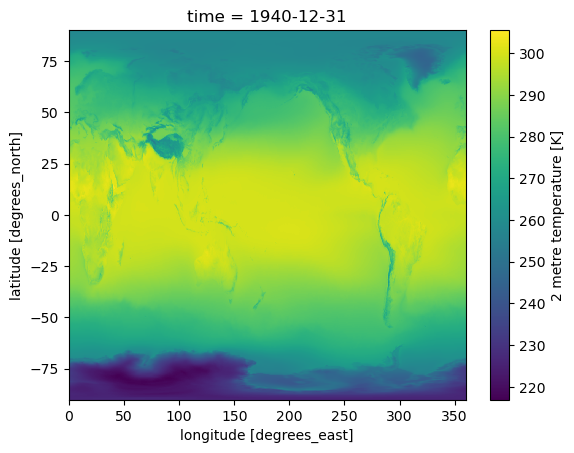Overview and Warning: Please Read¶
ERA5 data on NCAR is stored in hourly NetCDF files. Therefore, it is necessary to create intermediate ARCO datasets for fast processing.
In this notebook, we read hourly data from NCAR’s publicly accessible ERA5 collection using an intake catalog, compute the annual means and store the result using zarr stores.
If you don’t have write permision to save to the Research Data Archive (RDA), please save the result to your local folder.
If you need annual means for the following variables, please don’t run this notebook. The data has already been calculated and can be accessed via https from https://
data .rda .ucar .edu /pythia _era5 _24 /annual _means / - Air temperature at 2 m/ VAR_2T (https://
data .rda .ucar .edu /pythia _era5 _24 /annual _means /temp _2m _annual _1940 _2023 .zarr)
- Air temperature at 2 m/ VAR_2T (https://
Otherwise, please run this script once to generate the annual means.
Prerequisites¶
| Concepts | Importance | Notes |
|---|---|---|
| Intro to Xarray | Necessary | |
| Intro to Intake | Necessary | |
| Understanding of Zarr | Helpful |
- Time to learn: 30 minutes
Imports¶
import glob
import re
import matplotlib as plt
import numpy as np
import scipy as sp
import xarray as xr
import intake
import intake_esm
import pandas as pdimport dask
from dask.distributed import Client, performance_report
from dask_jobqueue import PBSCluster######## File paths ################
rda_scratch = "/gpfs/csfs1/collections/rda/scratch/harshah"
rda_data = "/gpfs/csfs1/collections/rda/data/"
#########
rda_url = 'https://data.rda.ucar.edu/'
era5_catalog = rda_url + 'pythia_era5_24/pythia_intake_catalogs/era5_catalog.json'
#alternate_catalog = rda_data + 'pythia_era5_24/pythia_intake_catalogs/era5_catalog_opendap.json'
annual_means = rda_data + 'pythia_era5_24/annual_means/'
########
zarr_path = rda_scratch + "/tas_zarr/"
##########
print(annual_means)/gpfs/csfs1/collections/rda/data/pythia_era5_24/annual_means/
Create a Dask cluster¶
Dask Introduction¶
Dask is a solution that enables the scaling of Python libraries. It mimics popular scientific libraries such as numpy, pandas, and xarray that enables an easier path to parallel processing without having to refactor code.
There are 3 components to parallel processing with Dask: the client, the scheduler, and the workers.
The Client is best envisioned as the application that sends information to the Dask cluster. In Python applications this is handled when the client is defined with client = Client(CLUSTER_TYPE). A Dask cluster comprises of a single scheduler that manages the execution of tasks on workers. The CLUSTER_TYPE can be defined in a number of different ways.
There is LocalCluster, a cluster running on the same hardware as the application and sharing the available resources, directly in Python with
dask.distributed.In certain JupyterHubs Dask Gateway may be available and a dedicated dask cluster with its own resources can be created dynamically with
dask.gateway.On HPC systems
dask_jobqueueis used to connect to the HPC Slurm and PBS job schedulers to provision resources.
The dask.distributed client python module can also be used to connect to existing clusters. A Dask Scheduler and Workers can be deployed in containers, or on Kubernetes, without using a Python function to create a dask cluster. The dask.distributed Client is configured to connect to the scheduler either by container name, or by the Kubernetes service name.
Select the Dask cluster type¶
The default will be LocalCluster as that can run on any system.
If running on a HPC computer with a PBS Scheduler, set to True. Otherwise, set to False.
USE_PBS_SCHEDULER = TrueIf running on Jupyter server with Dask Gateway configured, set to True. Otherwise, set to False.
USE_DASK_GATEWAY = FalsePython function for a PBS cluster
# Create a PBS cluster object
def get_pbs_cluster():
""" Create cluster through dask_jobqueue.
"""
from dask_jobqueue import PBSCluster
cluster = PBSCluster(
job_name = 'dask-pythia-24',
cores = 1,
memory = '4GiB',
processes = 1,
local_directory = rda_scratch + '/dask/spill',
resource_spec = 'select=1:ncpus=1:mem=8GB',
queue = 'casper',
walltime = '1:00:00',
#interface = 'ib0'
interface = 'ext'
)
return clusterPython function for a Gateway Cluster
def get_gateway_cluster():
""" Create cluster through dask_gateway
"""
from dask_gateway import Gateway
gateway = Gateway()
cluster = gateway.new_cluster()
cluster.adapt(minimum=2, maximum=4)
return clusterPython function for a Local Cluster
def get_local_cluster():
""" Create cluster using the Jupyter server's resources
"""
from distributed import LocalCluster, performance_report
cluster = LocalCluster()
cluster.scale(4)
return clusterPython logic to select the Dask Cluster type
This uses True/False boolean logic based on the variables set in the previous cells
# Obtain dask cluster in one of three ways
if USE_PBS_SCHEDULER:
cluster = get_pbs_cluster()
elif USE_DASK_GATEWAY:
cluster = get_gateway_cluster()
else:
cluster = get_local_cluster()
# Connect to cluster
from distributed import Client
client = Client(cluster)
# Display cluster dashboard URL
clusterFind data using intake catalog¶
era5_cat = intake.open_esm_datastore(era5_catalog)
era5_catera5_cat.df[['long_name','variable']].drop_duplicates().head()Select variable of interest¶
######## Examples of other Variables ##############
# MTNLWRF = Outgoing Long Wave Radiation (upto a sign), Mean Top Net Long Wave Radiative Flux
# rh_cat = era5_cat.search(variable= 'R') # R = Relative Humidity
# olr_cat = era5_cat.search(variable ='MTNLWRF')
# olr_cat
############ Access temperature data ###########
temp_cat = era5_cat.search(variable='VAR_2T',frequency = 'hourly')
temp_cat# Define the xarray_open_kwargs with a compatible engine, for example, 'scipy'
xarray_open_kwargs = {
'engine': 'h5netcdf',
'chunks': {}, # Specify any chunking if needed
'backend_kwargs': {} # Any additional backend arguments if required
}%%time
dset_temp = temp_cat.to_dataset_dict(xarray_open_kwargs=xarray_open_kwargs)dset_temp.keys()dict_keys(['an.sfc'])temp_2m = dset_temp['an.sfc'].VAR_2T
temp_2mtemp_2m_annual = temp_2m.resample(time='1Y').mean()
temp_2m_annualSave the notbeook¶
# temp_2m_annual.to_dataset().to_zarr(zarr_path + "e5_tas2m_monthly_1940_2023.zarr)temp_2m_monthly = xr.open_zarr(zarr_path + "e5_tas2m_monthly_1940_2023.zarr").VAR_2T
temp_2m_monthlytemp_2m_annual = temp_2m_monthly.resample(time='1Y').mean()
temp_2m_annual = temp_2m_annual.chunk({'latitude':721,'longitude':1440})
temp_2m_annual = temp_2m_annual.drop_isel({'time':-1}) # Drop 2024 data
temp_2m_annualSave annual mean to annual_means folder within rda_data¶
# %%time
# temp_2m_annual.to_dataset().to_zarr(annual_means + 'temp_2m_annual_1940_2023.zarr',mode='w')CPU times: user 392 ms, sys: 26.6 ms, total: 419 ms
Wall time: 6.36 s
<xarray.backends.zarr.ZarrStore at 0x1486704723c0>temp_2m_annual = xr.open_zarr(annual_means + 'temp_2m_annual_1940_2023.zarr').VAR_2T
temp_2m_annual %%time
temp_2m_annual.isel(time=0).plot()CPU times: user 118 ms, sys: 11.5 ms, total: 130 ms
Wall time: 389 ms

Close up the cluster¶
cluster.close()